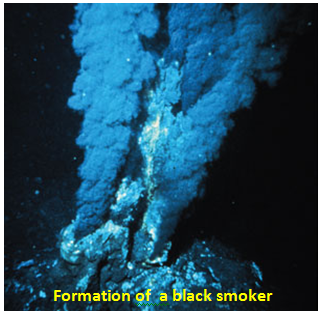- Screen Reader Access
- Skip to : main content / navigation
- Text Size
- Home
- Sitemap
- Contact us
- हिंदी
Modern seafloor hydrothermal systems, with their black/ white smokers issuing hot metal rich vent fluids from volcanic rocks can be considered as modern analogs for the formation of volcanic-hosted massive sulphide deposits. The discovery of such systems in the deep oceanic realm along the mid-ocean ridges has kindled a lot of interest primarily on account of the high concentration of base metals (Cu and Zn) and many noble metals (Au, Ag, Pd, Pt) in them. Apart from their economic potential, sea-floor hydrothermal vents are characterized by dense biologic communities. Over 700 species have been reported, making the vents among the most productive ecosystems on Earth.
The basic paradigm of hydrothermal activity involves sub-seafloor convective circulation of seawater through permeable rocks mainly driven by the upper mantle heat sources. At water depths up to 3,700 metres, hydrothermal fluids, having seeped from the ocean into subterranean chambers where they are heated by the molten rock beneath the crust, are discharged from the black smokers at temperatures up to 400° C. As these fluids mix with the cold surrounding seawater, metal sulphides in the water are precipitated onto the chimneys and nearby seabed. These sulphides, including galena (lead), sphalerite (zinc) and chalcopyrite (copper), accumulate at and just below the seafloor, where they form massive deposits that can range from several thousands to about 100 million tonnes.
Exploration for hydrothermal activity on the Indian Ocean ridge system was initiated with the GEMINO program in 1983. The encouraging results of this study and the discoveries of fossil ‘Sonne Field’ (‘MESO’ zone), as well as of the active ‘Kairei’ and ‘Edmond’ fields, the “Geodyn” plume site etc. suggest that the Indian Ocean Ridge system is also a potential site for the exploration of hydrothermal sulphides. Considering this, the Ministry of Earth Sciences has recently initiated a mission-mode multi-disciplinary program of hydrothermal studies at mid-ocean ridges, with emphasis on the South West and Central Indian Ridges. NCPOR has been designated as the nodal agency responsible for implementation of this program in its entirety. The work plan comprises systematic geophysical (gravity and magnetic) and multibeam bathymetric surveys, followed by water-column and seabed/sub-seabed sampling for geochemical tracers of hydrothermal activity, seabed sampling for rocks, TV –grab and still photographic surveys with real-time imaging and direct observations by ROVs.
 |
Building Cyber Resilience: Cyber Awareness Programme at NCPOR
Echoes from the Ends of the Earth – A National Level Short Filmmaking Competition
Strengthening International Collaboration in Polar and Ocean Sciences
The New Year at NCPOR began with a special address by Dr. Thamban Meloth, Director, NCPOR
The 46th Indian Scientific Expedition to Antarctica (46-ISEA)